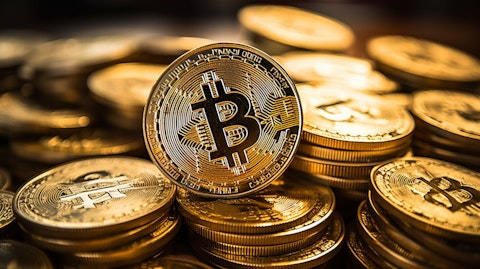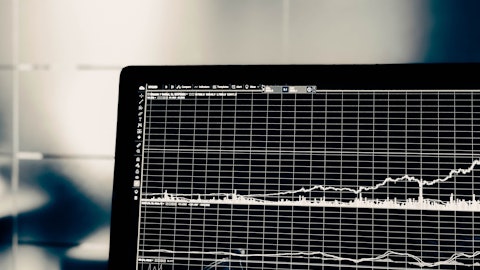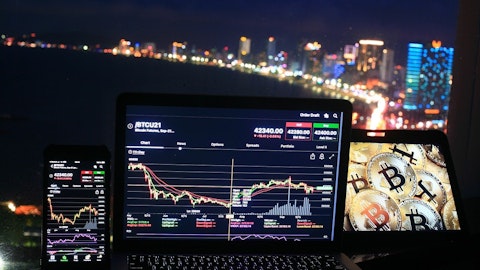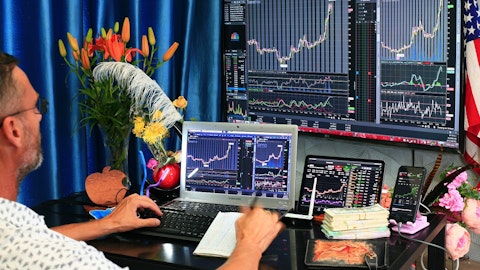Bitfarms Ltd. (NASDAQ:BITF) Q3 2023 Earnings Call Transcript November 7, 2023
Bitfarms Ltd. misses on earnings expectations. Reported EPS is $-0.07 EPS, expectations were $-0.03.
Operator: Good day, everyone, and welcome to the Bitfarms’ Third Quarter Financial Results Conference Call. All participants will be in a listen-only mode. [Operator Instructions] After today’s presentation, there will be an opportunity to ask questions. [Operator Instructions] Please note, this event is being recorded. I would now like to turn the conference over to David Barnard, LHA Investor Relations. Please go ahead, sir.
David Barnard: Thank you. Good morning everyone, and welcome to Bitfarms conference call for the third quarter of 2023. With me on the call today is Geoff Morphy, President and Chief Executive Officer, and Jeff Lucas, Chief Financial Officer. Before we begin, please note this call is being webcast live with an accompanying presentation. To watch along with the slides, you can log on to our website at www.bitfarms.com under the Investors Presentation section. If you prefer to listen to the call on your smartphone, you can download the presentation from there as well. I would like to remind you that this morning Bitfarms issued a press release announcing its third quarter 2023 financial results. Turning to Slide 2, I’ll remind everyone that certain forward-looking statements will be made during the call and future results could differ from those implied in these statements.

The forward-looking information is based on certain assumptions and is subject to risks and uncertainties, and I invite you to consult Bitfarms’s MD&A for a complete list of these. Also, during the call, reference will be made to supporting slides, and you can find the presentation on our website www.bitfarms.com under the Investor Relations section. The company will also refer to certain measures not recognized under IFRS, and they do not have a standardized meaning prescribed by IFRS, and therefore, may not be comparable to similar measures presented by other companies. We invite listeners to refer to today’s earnings release and the company’s third quarter 2023 MD&A for definitions of the aforementioned non-IFRS measures and the reconciliations to IFRS measures.
Please note that all financial references are denominated in U.S. dollars unless otherwise noted. During today’s call, CEO, Geoff Morphy will review our operations for the quarter. And CFO, Jeff Lucas will follow with a detailed financial review and Geoff Morphy will return for some closing remarks after the Q&A. We have also requested investors to send questions in advance, which I will read to management after we open the call to analysts interested in the live Q&A. Turning to Slide 3 and then on to Slide 4. It’s my pleasure to turn the call over to Geoff Morphy.
Geoff Morphy: Thank you for joining us today. I’m excited to review highlights of our third quarter performance and our strategic outlook with you. The timing of capital investments is the most important factor of the four year Bitcoin mining cycle. As such, we continue to follow a disciplined plan, stressing an attractive ROI hurdle for upgrades and new projects so that we are best positioned for the having in April of 2024 and beyond. We plan to move aggressively to capitalize on improving market conditions going into the having and capture market share consolidation opportunities that will likely arise post having. This in conjunction with sustained and predictable costs of operation we believe will drive long term value.
I’ll elaborate. First, until the last 30 days, we deem miners to be at unacceptably high prices, to avoid overzealous spending, to achieve high growth targets with unacceptable returns, we exercise patience and discipline. Two, throughout 2023, we prudently fortified our balance sheet and made modest opportunistic expansion moves such as at Baie-Comeau and in Paraguay. Three, we remain committed to investing in new facilities and minor upgrades. Now, with the Bitcoin rally and the recent introduction of new high performance miners at lower costs, we are focusing on opportunities to take advantage of more competitive pricing for equipment upgrades. Four, combined with years of international development in securing surplus energy and realizing low direct costs while reducing overhead, we are well positioned to continue our expansion and further reduce corporate operating costs.
On Slide 5, I’ll review some of our accomplishments for Q3 2023 and post third quarter events. In September, we fully energized our first warehouse in Río Cuarto, increasing exahash per second to 6.1 at quarter close, up 15% from June 30, 2023 and up 45% from September 30, 2022. In October in Baie-Comeau, we completed the first phase of expansion, increasing from five megawatts to 11 megawatts, bringing our corporate hash rate to 6.3 exahash per second. During Q3 2023, we earned 1,172 Bitcoin compared to 1223 earned in Q2 2023, reflecting increased network difficulty. Q3 2023 revenue remained consistent at 35 million compared to Q2 2023, reflecting network difficulty increases offset mainly by our hash rate increase. Adjusted EBITDA was $7 million for Q3 2023 and our Bitcoin holdings increased to 703 at September 30, 2023.
Slide 6 shows a summary of our operating capacity and installed miners. Our diversified portfolio comprises eleven operating farms in four countries as well as two more in development. In October 2023, we reached 240 megawatts in operating capacity, up 32% from a year ago, with long-term and low cost energy contracts totaling 573 megawatts. Only 42% of contracted capacity has been placed into operation, highlighting our considerable embedded development runway, I will now review our operations and development plans. Turning to Slide 7 in Paraguay, we acquired two hydropower purchase agreements, one for 50 megawatts Paso Pe adjacent to Villarrica and another for 100 megawatts at Iguazu. We expect the new Paso Pe 50 megawatt farm construction to be completed in Q1 2024 and development is progressing quickly.
For civil work, we have been preparing the site, improving the access road and constructing the high voltage substation connection. We anticipate completing most of the substation building and the production buildings by year end 2023. For equipment, we purchased 20 megawatts of MicroBT hydro-cooling miners and related containers, primarily employing 19 million of vendor credits, substantially reducing the capital outlay for this farm. These hydro miners utilize the latest mining technology and feature among the best efficiencies in the industry, which will drive significantly lower costs of operations. The additional 30 megawatts of capacity would be housed in two aircooled warehouses currently under construction. For nominal added cost, we purchased the high voltage transformer rated at 80 megawatts, creating optionality for more expansion at Paso Pe. I’ll add that the timely delivery of this transformer is key in meeting our Q1 2024 operating target and progress reports from the manufacturer indicated is on schedule.
At Iguazu, the site selection process is going well and the final decision will be reached that fully aligns with our timeline in 2024. Turning to Slide 8 in Río Cuarto in Argentina, by modifying the rack layout, we managed to expand capacity from 50 megawatts or 54% beyond original design with 7,500 new miners installed in Q3 2023, we added 800 petahash per second and brought our hash rate to over 1.6 exahash per second in October. Notably in Argentina, October 1 marked the start of the summer season when natural gas is typically less expensive. During this seven month period, we expect fully loaded energy costs at Río Cuarto to be reliably below $0.03 per kilowatt hour compared to between $3.5 during the winter months. This makes Río Cuarto amongst the lowest cost operating facilities in the industry.
As this farm represents about 23% of our operating capacity, it will reduce our direct cost per Bitcoin, which is one of our strategic goals. In summary, our LATAM investments are poised for growth in the coming investment cycle. Bitfarms benefits from exceptionally low costs in this region and there are significant barriers to entry to LATAM, uniquely positioning us in this region to capitalize on low cost expansion opportunities. For example, we have paid our dues in Argentina and others looking to duplicate our development efforts in this low cost country will face many organizational and logistical challenges. We have a track record and a strong team. We have also achieved qualification as a self importer of miners and retain an additional 156 megawatts of contracted low cost power for future development in Rio Cuarto.
In short, we remain excited about the long-term prospects for further development in the country. And in Paraguay, we have one operating farm and 150 megawatts under development. In Canada – in early July, we closed the purchase of Baie-Comeau and initiated operation at five megawatts. In October, we achieved our plan of activating the first 11 operating capacity. We plan to complete the construction of the additional 11 megawatts in the second half of 2024, coincident with the delivery of power to the facility. In Magog, we further optimized the facility as we imported and installed approximately 2,900 high efficiency S-19 Pro Plus miners. We concurrently relocated the older miners to the Baie-Comeau facility. By increasing the density of rack miners at both farms, we netted an increase of 110 petahash per second at Magog and provided a cost effective capital deployment at Bay Como.
In Washington State, we upgraded ventilation and cooling systems, increasing average uptime while we took two megawatts offline, reducing total operating capacity to 18 megawatts. We are in the process of various facility modifications and improvements. To elaborate, we are adding fiber optics to reduce latency between buildings and constructing a new warehouse. These improvements in operating practices will result in greater efficiencies in early 2024. Please turn to Slide 9. With that, I will now hand the call over to Jeff Lucas for the financial review.
Jeff Lucas: Thank you, Geoff. I’ll begin by highlighting some key elements of our financial strategy and position. We have efficient operations predicated on our operational excellence and with the majority of our energy from green hydropower, stable and predictable energy rates that are not subject to the variability associated with fossil fuels and in the case of Argentina which derives energy from natural gas, a positive contribution overall with the lowest energy cost of our portfolio. We have a laser focus on return on investment at the individual project level and rapid payback of capital at the corporate level. We’ve achieved our 2023 Growth Plan by the end of October and for 2024 we have a minor upgrade in infrastructure expansion plan that will provide significant growth to our hashrate and our competitive efficiency.
And we have maintained throughout this a strong balance sheet that now positions us to utilize our operational expertise to take advantage of these fleet upgrades now and the attractive growth opportunities arising from unpredictable economics of the Halving. I’ll now review our financial performance for the quarter, production economics and our balance sheet. Turning to Slide 10. In the third quarter of 2023 as Geoff pointed out, we earned 1,172 Bitcoin compared to 1,223 Bitcoin in the second quarter of 2023 and 1,515 in the third quarter of 2022. Our hashrate was 15% higher sequentially and 45% higher year-over-year. This achievement was offset in part by increases in average network difficulty of 9% over the second quarter 2023 and 82% year-over-year.
Our third quarter total revenue was $35 million, comprised of $33 million from our mining activities and $2 million from our electrical subsidiary Volta. This compares to $35 million overall in the second quarter of 2023 and reflects slightly higher average Bitcoin price quarter-over-quarter and 4% through a Bitcoin earned during the quarter due to the difficulty. Focusing on our production economics as illustrated on Slide 11. In the third quarter of 2023, Bitfarms direct cost of production per Bitcoin was $16,900, up from $15,700 per Bitcoin in the second quarter of 2023. This change reflects the increased network difficulty, offset in part by approximately 3% low electricity rates quarter-over-quarter. While our total direct cost was up in Q3 2023 at Rio Cuarto, the site with our lowest cost power, it was in fact under $12,000 for the quarter for Bitcoin.
And we should benefit more fully going forward as Rio Cuarto wasn’t fully energized to its 50 plus megawatt capacity until September and has become a large proportion of our overall portfolio. As on our last call, I’d add one more caveat to those building financial models. Our direct cost since February 2022 includes a 15% value-added tax on Canadian energy costs as a result of recent legislation. We firmly believe that we are exempt from this incremental tax and are pursuing a revenue ruling with the Canadian and the Quebec tax authorities to formalize our exempt status. More to come in this matter, but I will state that without this tax, our direct cost per BTC in the third quarter would have been about $15,200, $1,700 less than our reported direct cost per BTC overall.
Third quarter gross mining profit was $13 million, or 38% of mining revenue compared to $14 million or 42% of mining revenue in the second quarter of 2023. As with the reduction in our production economics, the decrease in the gross mining margin reflected the increase in network difficulty. The total cash cost for BTC was $22,700 in the third quarter of 2023, up from $21,800 in the second quarter. Higher network difficulty was a primary driver, leading to fewer Bitcoin during the quarter and higher energy costs per Bitcoin. General and administrative expenses or G&A decreased compared to the prior quarter, which largely reflects our focus on reducing operating expenses, including savings and insurance costs, attributable to lower replacement values for our fleet and risk mitigation measures implemented companywide.
Going forward, we plan to tackle the combined effects of the Halving and the increase in difficulty by upgrading the mining fleet with some of the recently announced and highly efficient mining models and reducing our G&A cost structure, including lowering professional fees and discretionary spending. Moving now to Slide 12. For the third quarter, our operating loss was $19 million, this includes non-cash depreciation expenses of $22 million. This also compares to the second quarter operating loss of $25 million, which includes depreciation expense of $21 million and an impairment charge on short-term prepaid deposits and property, plant and equipment of $10 million. Our net loss for the third quarter was $19 million, or $0.07 per basic and fully diluted share, compared to a net loss for the second quarter of 2023 of $25 million, or $0.10 per basic and fully diluted share.
As previously noted, slightly higher average Bitcoin prices were offset by increases in network difficulty, which impacted the bottom line. Adjusted EBITDA was $7 million in the third quarter of 2023, as compared to $8 million in the second quarter of 2023. The adjusted EBITDA equates to profitability per Bitcoin of about $5,900 in the third quarter versus $6,300 in the second quarter. Turning now to Slide 13. At September 30, we held cash of $47 million and Bitcoin valued at $19 million for total liquidity of $66 million. This compares to $31 million cash and $48 million total liquidity at June 30, 2023. During the third quarter of 2023, of the 1,172 Bitcoin we earned, we sold 1,018 to generate $28 million of proceeds to fund our operating and debt service requirements and deposited 154 BTC into treasury with a September month end value of a little over $4 million.
In October, we deposited another 57 Bitcoin, increasing Bitcoin in custody on October 31 to 760 Bitcoin, representing a total value of approximately $26 million based on the Bitcoin price that day of $34,200. In the third quarter of 2023 we raised $31 million in net proceeds from our ATM program, which expired on September 12. The monies we raised under our ATM are specifically earmarked for the growth initiatives about which Geoff spoke. We continued to use cash generated from operations to deleverage our balance sheet. Total indebtedness was reduced to $10 million at September 30 and to under $8 million at October 31. As we’ve noted in previous earnings calls, our debt related to our Bitcoin activities is scheduled to be fully repaid by the end of February 2024 well in advance of the Halving.
Before I hand the call back to Geoff, I’ll take a moment to highlight one of our new initiatives, the Synthetic HODL. At our Analyst Day in September, we introduced our concept of using the Synthetic HODL to achieve a capital efficient portfolio. The primary objective of the Synthetic HODL is to enable us to accumulate BTC and treasury and increase the company’s BTC exposure in a manner that is risk managed and capital efficient. With it, we maintain discretion to dynamically adjust our hedge and Synthetic HODL ratios within risk limits to respond to market factors. In October, we initiated our strategy with the purchase of long dated BTC call options. As of November 6, using the Synthetic HODL, the company has increased its upside to BTC prices by 35 BTC equivalent exposure.
Turning to Slide 14, I’ll now turn the call back over to Geoff.
Geoff Morphy: Thank you, Jeff. Before I open the call for questions, I would like to mention some upcoming events, including the Benzinga Future of Crypto Conference in New York on November 14 and the Blockchain Jungle Conference in Costa Rica on November the 16. Referring to Slide 16. In summary, we are following a highly disciplined capital allocation strategy with projects to be completed ahead of the Halving in April. Fleet upgrades will reduce our costs of operation and the patience we exercised in 2023, we expect will pay off well in 2024. Over the past 12 months, we’ve increased our hashrate to 45%, achieving our 2023 target of 6.3 exahash in October. The first 50 megawatts of our 150 megawatt expansion in Paraguay is underway and opportunities that meet our criteria for growth and lowering our costs both before and after the Halving are abundant.
We expect to achieve 7 exahash in Q1 2024 with the energization of hydro miners currently on order for Paso Pe, with additional capacity there coming from the 30 megawatt air cooled warehouses. With newly signed PPAs, we have significant and low cost expansion projects to develop when conditions warrant following the Halving. This is an exciting time in the industry cycle and we are well positioned to leverage our core competencies and advance Bitfarms’ global operations in a new phase of diversified and accretive growth, while working strategically and steadfastly to reduce our production costs. Operator, we can now open the call for questions. Over to you, David. Please go ahead.
A – David Barnard: Okay. Thanks, Geoff. Yes, just before we go to the analyst QA, there’s two questions that we got from online in advance of the call. I’ll just read out the first one to you. You seem to be more positive in your outlook today than at your Analyst Day back in mid-September. Could you elaborate on why?
Geoff Morphy: I’d be happy to take that one. Well, the climate is different now. It’s much more positive. Let me elaborate. Bitcoin, which was trading sideways for the longest time, $26,000, $27,000, $28,000, is now $34,000, $35,000. That’s 26% to 30% higher than it was. The hash price that we saw not very long ago was $0.06 and a little bit under $0.06 per T. Now it’s over $0.07 I think. That helps the margins and certainly helps our optimism. We are reading and seeing record inflows of cash going into the exchanges with new excitement coming around the Bitcoin, around Bitcoin and Bitcoin purchases. And I think that’s fueling some of the price increases. Part of that is also all the news about the ETFs coming. It sure sounds like there’s going to be approvals coming in December and probably them going live early in the new year.
And that’s going to be a phenomenal opportunity for the whole industry in terms of credibility and adoption and more investment. And then just in the last two weeks, we have multiple manufacturers announcing new miners that will be released in the first quarter of next year at less cost and sub-20 joules per terahash performance. That adds up to a lot of optimism in our eyes. And as we’ve said in the past, we want to be opportunistic. And it sure looks like this is a good time to be opportunistic.
David Barnard: Great. Thanks, Geoff. And I’ll just give you one other one from the online community. You seem to be accelerating the pace of growth in LatAm. What is motivating this move over further growth in Canada?
Geoff Morphy: Jeff Lucas, do you want to start with that one?
Jeff Lucas: Sure. I’m glad to do so here. So the biggest driver for us, naturally, is the lowest energy cost. And currently Canada’s costs are a little north of $0.04, albeit, when that VAT tax is removed, it’ll be probably a little below $0.04. But for us right now, the most opportunistic region of the world and where we have a very strong foothold is in Latin America and particularly developments in Paraguay. So really the driving force behind that is the fact that we have electricity right now in Paraguay that’s a little north of $0.038 or so. Further opportunities, we believe, for additional cost reductions. And to us, it’s the most promising region and the most economically compelling region at this point in time.
David Barnard: Okay. Operator, I think we can go to the QA.
See also 11 Most Undervalued Solar Stocks To Buy According To Hedge Funds and 12 Best Undervalued Dividend Stocks To Buy Now.
Q&A Session
Follow Bitfarms Ltd.
Follow Bitfarms Ltd.
Operator: Thank you. [Operator Instructions] Our first question comes from Bill Papanastasiou with Stifel. Please go ahead.
Bill Papanastasiou: Hi, gentlemen. Good morning. Thank you for taking my questions.
Geoff Morphy: Hi, Bill.
Bill Papanastasiou: Yes, I really appreciate the commentary at the beginning on the importance of timing your capital investment. And clearly Bitfarms has a very strong balance sheet with a ton of liquidity and debt that’s going to be paid off in the New Year prior to the having. And you also have this situation of attractive pricing which you alluded to. I’m curious to hear whether you could share more details in terms of what hardware models look most attractive to your team today? I know your team has been very diligent with calculating payback periods and so just hoping to get an update to that end.
Geoff Morphy: Sure. Well, I think the industry has all been very much keen on these new miners being announced in particularly the Bitmain S21s and T21s are very attractive. The pricing is very good and sub-20 watts is really changing the landscape. The pricing and performance is better than the last generation of miners, which we thought were just too expensive. And while other people were just growing and buying these models, we just said it’s hard to get the paybacks, particularly $0.06 [ph] per entitled of hash price. And those paybacks were long and it was not a good use of capital. So we had to hold back. But we think now the environment is much better, and we are looking at this new generation of miner, which will be available starting early next year and to put in some of our facilities and also upgrade the fleet as people have commented in the past, we have quite a number of M30s and M31s.
So some of the replacements there, if we can do it, would be quite remarkable in terms of our performance.
Bill Papanastasiou: Great. Thank you for that color. And then for my final question. You’ve been able to optimize and kind of maximize every square inch at the first warehouse in Argentina. And it’s a no brainer, right. Very attractive, low cost power. I’m just wondering whether the appetite or the outlook for further expansion in Argentina has changed at all. I understand your team is heads down on the Paraguay extension, but just hoping to get some more outlook to that end.
Geoff Morphy: Bill, it’s great to have flexibility and it’s great to have good people in all of our local markets. It really opens up opportunities for us. I guess, we’ve said, we paid our dues in Argentina. We have a superb team in Buenos Aires, managing the region. We have a superb team in Rio Cuarto that’s now well trained. And we were able to push – put another row of miners in there, take full advantage of the primary transformer there, and move that up by 6% to 8% and all with new miners. So we’re 1.6 EH/s there now. Quite remarkable. And it’s an area which we’ve learned sometimes by mistakes and sometimes by good fortune, but we keep trying hard and then figuring out sort of how to adjust things along the way. So until we got ourselves up and really primarily using all the output from that transformer at sort of 50 megawatts, but facility wasn’t optimized.
And we were always saying when we optimized facility, we could bring the cost down. So like in the summertime, we were seeing sort of $0.036 per kilowatt hour after the translation, September, it dropped below $0.03. And now we’re in the summer months where we’re going to get seven months, probably price – probably prices closer to $0.025 than $0.03. But once again, let’s see what actually materializes. And we also have the same situation. Let’s see what materializes from the election coming on November the 19th. So it’s an area that we’re excited for because the costs are low, but we want to walk before we run and make sure that we don’t make any expensive mistakes. So once we get a little more confidence, then this really could open up this opportunity.
And at some point in 2024, when the economics are right, and 2025 sort of and beyond for sure, but we have the land, we have the contracts. It really represents a very low cost opportunity. We’re 23% of the overall book right now, and that’s bringing down our cost of production. And that’s a real strategic goal for us, is bring those costs down.
Bill Papanastasiou: I appreciate that color. Thank you, gentlemen. I look forward to seeing that hard earned cash being used towards some fee upgrades. Thank you.
Geoff Morphy: Very good.
Operator: Our next question comes from Josh Siegler with Cantor Fitzgerald. Please go ahead.
Josh Siegler: Yes, hi, guys. Thanks for taking my call today. Congrats on the lower G&A. Great to see that profitability improvement. For my first question, I wanted to touch on financing. So obviously you’ve been paying down the debt and improving the balance sheet over time. Would you ever consider taking on additional debt burden if it made the right sense from financing perspective? And can you give an update on whether those debt markets have opened up to you?
Jeff Lucas: Sure, Josh, let me speak to that here. I can. We have seen some pretty interesting instruments out there, primarily from, I think, hedge funds, convertible debt outstanding here. And look, in a general picture, there is room for debt on the balance sheet to a degree, in the sense that it lowers your overall cost of capital, particularly on a tax adjusted basis here. We estimate both for our own calculations that the cost of equity for the sector and for us is between 30% and 35%. So if you can indeed get debt with an all in cost of maybe 15% to 18% here, and then that’s tax adjusted afterwards, that doesn’t make it attractive. Of course, given the variability and the volatility of the industry in which we operate and the fact that the biggest drivers, i.e. Bitcoin pricing and network difficulty, are largely beyond our control.
We do that very, very judiciously. At this point in time, Josh, we don’t have any immediate plans to incur debt on the balance sheet. But again, if conditions change and for the right opportunity, we would consider that on a limited basis.
Geoff Morphy: Hey, Josh. And I’ll remind people that coming into the having, we expect network correction and things like that. We’ve said before, we do not want any debt obligations at that point. We don’t know how severe this can get, because it depends on pricing, which is out of our control. So we want to be as lean as possible, so we can take maximum advantage of opportunities post having.



